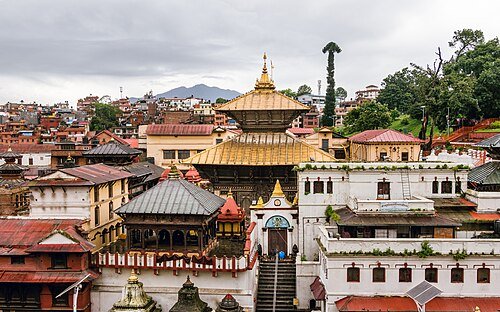Shrawan, the holiest month dedicated to Lord Shiva, holds immense spiritual significance for Hindus across Nepal. Devotees fast, wear green bangles, and visit Shiva temples in Kathmandu Valley in large numbers especially on Mondays, which are considered sacred to Lord Shiva. If you’re in Kathmandu during Shrawan, visiting these divine shrines will not only elevate your spiritual journey but also immerse you in the rich cultural essence of Nepal.
In this guide, we’ll walk you through 5 must-visit Shiva temples in Kathmandu Valley that become epicenters of devotion during the holy month of Shrawan.
1. Pashupatinath Temple: The Heart of Shiva Devotion
There is no better place to begin your Shrawan spiritual journey than Pashupatinath Temple, one of the most sacred Shiva temples not just in Nepal but across the Hindu world. Located on the banks of the Bagmati River, this UNESCO World Heritage Site draws thousands of devotees every Monday in Shrawan.

Shiva temples in Kathmandu Valley – Pashupatinath Temple
Why Visit During Shrawan?
Special rituals and Shiva pujas are conducted daily.
Massive crowd gathers every Monday for darshan and blessings.
Many women fast and pray for marital bliss and family well-being.
Tip: Arrive early in the morning to avoid long queues and witness the beautiful morning aarti.
2. Gokarneshwar Mahadev: The Protector of Ancestors
Located in the Gokarna area of northeast Kathmandu, Gokarneshwar Mahadev Temple is another prominent spiritual site. It is believed to be the protector of ancestors, and thus, people often visit it during Shrawan as well as during Gokarna Aunsi (Father’s Day in Nepal).
What Makes It Special?
Heavily crowded on Shrawan Mondays.
Serene surroundings, ideal for quiet prayer and reflection.
Believers offer tarpan (ritual for ancestors) here.
Cultural Note: This temple is also an important place for pitri-karma (ancestor rites), making it unique among Shiva temples in Kathmandu Valley.
3. Doleswor Mahadev Temple: The Hidden Kedarnath Connection
Situated in Bhaktapur, Doleswor Mahadev Temple holds a unique place in Hindu mythology. It is believed to be the head part of Lord Kedarnath in India. According to legend, when Lord Shiva disappeared into the earth to avoid the Pandavas, his body parts surfaced at different places and the head appeared in Bhaktapur.
Spiritual Importance:
Considered a part of the Panch Kedar pilgrimage for those who can’t visit India.
A peaceful and spiritually enriching environment.
Gains attention especially during Shrawan as a substitute pilgrimage destination.
Getting There: A short drive from Bhaktapur main city center and a great add-on to your spiritual itinerary.
4. Santaneshwor Mahadev: Prayers for Parenthood
Located in Godawari, Lalitpur, Santaneshwor Mahadev Temple is famous among couples who pray for children. During Shrawan, this temple becomes a sanctuary for hopeful families and newlyweds seeking divine blessings for parenthood.
Why Pilgrims Flock Here in Shrawan:
Rituals and pujas performed specifically for fertility and well-being.
Beautiful hilltop location surrounded by nature and tranquility.
Devotees tie red and green threads to sacred trees while making a wish.
Fun Fact: “Santan” means child, making it a special place for family-related prayers.
5. Kailashnath Mahadev: Nepal’s Tallest Shiva Statue
Standing tall in Sanga, between Bhaktapur and Kavre, the Kailashnath Mahadev Statue is the tallest Shiva statue in Nepal and the second tallest in the world. At 143 feet (43.5 meters), this giant statue of Lord Shiva is visible from miles away and attracts both devotees and tourists.
Must-See Highlights:
Perfect combination of spiritual energy and architectural wonder.
Panoramic views of the valley from the statue base.
During Shrawan, a large number of pilgrims come for group prayers and blessings.
Photo Opportunity: Don’t forget to capture the divine presence of Lord Shiva with the hills in the background.
Tips for Visiting Shiva Temples in Kathmandu Valley During Shrawan
Wear green if you’re a woman observing the fast—it’s symbolic during Shrawan.
Carry offerings like bel leaves, milk, curd, and flowers.
Visit temples early in the day to avoid large crowds and long queues.
Respect temple customs: remove shoes, follow lines, and don’t push.
Avoid non-veg food and alcohol during Shrawan if you’re observing the month spiritually.
Why Shiva temples in Kathmandu Valley Shrawan Is So Special for Shiva Devotees
The month of Shrawan is deeply associated with penance, devotion, and the pleasing of Lord Shiva. According to Hindu mythology, during the Samudra Manthan (churning of the ocean), Lord Shiva drank poison to save the universe, and to soothe his body, devotees started offering water, milk, and curd during this month.
That’s why visiting Shiva temples in Kathmandu Valley during Shrawan is more than just a ritual—it’s a path to spiritual renewal and divine connection.
Whether you’re a local or a traveler seeking spiritual immersion, the holy month of Shrawan offers a unique opportunity to explore the Shiva temples in Kathmandu Valley. Each temple has its own history, energy, and divine presence that adds to the spiritual tapestry of this sacred region.
If you’re planning your itinerary for Shrawan, make sure to include these five iconic temples your spiritual heart and soul will thank you for it.


